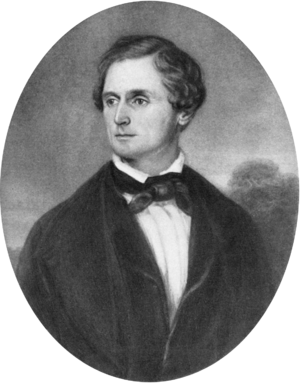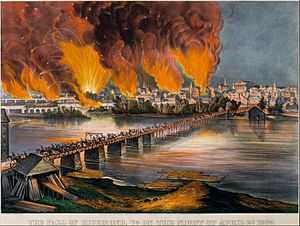Jefferson Davis facts for kids
Quick facts for kids
Jefferson Davis
|
|
|---|---|
 |
|
| President of the Confederate States | |
| In office February 18, 1861 – May 10, 1865 acting: February 18, 1861 – February 22, 1862 |
|
| Vice President | Alexander H. Stephens |
| Preceded by | Position established |
| Succeeded by | Position abolished |
| 23rd United States Secretary of War | |
| In office March 7, 1853 – March 4, 1857 |
|
| President | Franklin Pierce |
| Preceded by | Charles Conrad |
| Succeeded by | John Floyd |
| United States Senator from Mississippi |
|
| In office March 4, 1857 – January 21, 1861 |
|
| Preceded by | Stephen Adams |
| Succeeded by | Adelbert Ames |
| In office August 10, 1847 – September 23, 1851 |
|
| Preceded by | Jesse Speight |
| Succeeded by | John McRae |
| Member of the U.S. House of Representatives from Mississippi's At-large district |
|
| In office December 8, 1845 – June 1, 1846 |
|
| Preceded by | Tilghman Tucker |
| Succeeded by | Henry Ellett |
| Personal details | |
| Born | June 3, 1808 Fairview, Kentucky, U.S. |
| Died | December 6, 1889 (aged 81) New Orleans, Louisiana, U.S. |
| Resting place | Hollywood Cemetery |
| Political party | Democratic |
| Spouses | Sarah Knox Taylor (June–September 1835) Varina Banks Howell (1845–1889) |
| Alma mater | Transylvania University United States Military Academy |
| Signature | |
| Military service | |
| Allegiance | |
| Branch/service | United States Army |
| Years of service | 1828–1835 1846–1847 |
| Rank | |
| Unit | 1st Dragoons Mississippi Rifles |
| Battles/wars | Black Hawk War Mexican-American War |
Jefferson Fine Davis (June 3, 1808 – December 6, 1889) was an American political leader. He served as the only President of the Confederate States throughout the American Civil War, from 1861 to 1865.
Contents
Early Life and Education
Jefferson F. Davis was born on June 3, 1808, in Fairview, Kentucky. He was the youngest of ten children. His father, Samuel Davis, had fought in the American Revolutionary War. Jefferson was named after then-President Thomas Jefferson.
When Davis was young, his family moved to a farm near Woodville, Mississippi. His father grew cotton and owned enslaved people. Jefferson attended several schools, including Saint Thomas College in Kentucky and Transylvania University in Lexington, Kentucky. His father died in 1824.
Early Career and Family
Davis served as an officer in the United States Army until 1835. He then married Sarah Knox Taylor, the daughter of General (and future President) Zachary Taylor. Sadly, Sarah died from malaria just three months after their wedding. Davis then became a cotton farmer in Mississippi, where he owned many enslaved people.
In 1845, Davis married Varina Howell. That same year, he was elected to the United States House of Representatives, serving for one year. From 1846 to 1847, he fought in the Mexican–American War as a colonel. After the war, he was appointed to the United States Senate in 1847.
In 1853, President Franklin Pierce chose Davis to be his Secretary of War. After Pierce's time as president ended in 1857, Davis returned to the Senate. He resigned from the Senate in 1861 when his home state of Mississippi decided to leave, or secede, from the United States.
President of the Confederate States
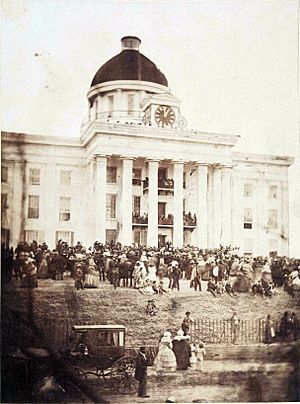
After Mississippi left the Union, Davis was appointed a major general in Mississippi's army. On February 10, 1861, he learned that he had been chosen as the provisional president of the Confederate States of America. This new nation was formed by states that had seceded from the U.S. Davis was chosen because he was a well-known politician and had military experience. He became president on February 18, 1861.
The Civil War Begins
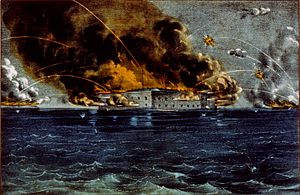
As Southern states left the Union, they took control of most federal buildings. However, some forts, like Fort Sumter in Charleston, South Carolina, remained under U.S. control. Davis wanted to avoid fighting at first, so the Confederacy could get organized. He sent a group to Washington to try and negotiate for the forts to be given up. But U.S. President Lincoln refused to meet with them.
When Lincoln said he would send supplies to Fort Sumter, Davis ordered the fort to surrender. When the fort's commander refused, Confederate troops attacked Fort Sumter on April 12. After more than 30 hours of fighting, the fort surrendered. This battle marked the start of the American Civil War. After Lincoln asked for volunteers to fight the rebellion, four more states joined the Confederacy.
1861: Early Battles
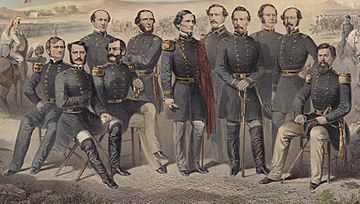
As president, Davis was the commander-in-chief of the Confederate army. Major fighting began in Virginia in July 1861. Confederate forces won the Battle of Manassas. In the West, a Confederate general violated Kentucky's neutrality by occupying a town. This led Kentucky to ask the Union for help, which meant the Confederacy lost a chance to gain the state.
1862: Challenges and Changes

In February 1862, the Confederacy faced major losses in the West. Union forces captured important forts and cities like Nashville and Memphis. Davis worked to gather more troops. He approved an attack at Shiloh in Tennessee, but the attack failed, and a key general was killed.
On February 22, Davis was officially inaugurated as president. He admitted the South had faced problems but urged people to keep fighting. He appointed General Robert E. Lee as his military advisor. They became close, and Davis relied on Lee's advice for the rest of the war.
In the East, Union troops attacked Virginia, moving close to the Confederate capital of Richmond. Davis and Lee wanted General Joseph Johnston to defend Richmond strongly. When Johnston was wounded, Davis put Lee in command. Lee then pushed the Union forces back from Virginia. Lee also stopped another Union army in August 1862. Lee then invaded Maryland, but after a tough battle, he retreated back to Virginia.
1863: Turning Points
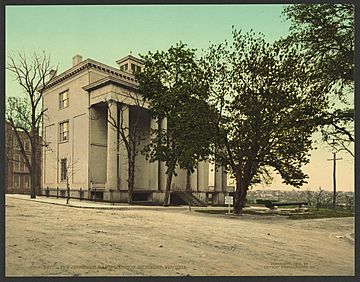
On January 1, 1863, President Lincoln issued the Emancipation Proclamation, which declared many enslaved people in Confederate states free. Davis saw this as an attempt to cause trouble in the South.
In May, Lee won a battle in Virginia and then invaded Pennsylvania. Davis hoped a victory in Union territory would help the Confederacy gain recognition from other countries. However, Lee's army was defeated at the Battle of Gettysburg in July.
In the West, Union forces attacked Vicksburg, Mississippi. Despite Davis's efforts to send troops, Vicksburg surrendered on July 4. This loss gave the Union control of the Mississippi River. Later in the year, a Confederate army was defeated in northern Georgia.
During this time, many Confederate cities faced food shortages and rising prices. Davis tried to encourage people and even faced a riot in Richmond, where he convinced protesters to go home. He also traveled across the South to rally support.
1864–1865: Final Years of War
In 1864, Davis believed the Confederacy could win by making the Union tired of fighting. He thought if the South showed it could not be defeated, the North would elect a president who would make peace.
In Georgia, Union armies advanced towards Atlanta. Davis replaced General Joseph Johnston with General John B. Hood. Hood fought hard but could not stop the Union forces, and Atlanta was lost in September. This victory helped Lincoln win reelection in the North. Union forces then marched through Georgia to the sea.
In Virginia, Union forces advanced again. Lee's army fought strongly, leading to a long period of trench warfare around Petersburg. In February 1865, Davis made Lee the general-in-chief of all Confederate armies. Davis also sent people to talk about peace, but Lincoln would not agree to an independent Confederacy.
Late in the war, Davis supported the idea of allowing African Americans to join the Confederate army in exchange for their freedom. However, this idea came too late to change the war's outcome.
End of the Confederacy and Capture
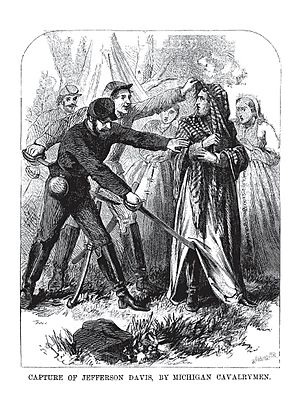
At the end of March 1865, Union forces broke through Confederate lines, forcing Lee to leave Richmond. Davis and his cabinet escaped by train. On April 9, Lee surrendered his army. Davis still wanted to continue fighting, but his generals told him they had no forces left.
After President Lincoln was assassinated on April 14, the U.S. government wrongly thought Davis was involved and offered a reward for his capture. On May 5, Davis officially ended the Confederate government. He was captured on May 9, 1865, near Irwinville, Georgia.
Imprisonment and Release

On May 22, Davis was imprisoned at Fort Monroe, Virginia. At first, his treatment was harsh, but it improved over time due to public concern. He was allowed to read and eventually had better living quarters. His wife, Varina, was also allowed to visit him regularly.
The U.S. government considered trying Davis for treason. Davis himself wanted a trial to clear his name. After two years in prison, Davis was released on bail on May 13, 1867. Important citizens helped pay his bail. Davis and his family moved to Canada for a time. His case for treason never went to trial. In 1868, President Andrew Johnson gave amnesty to all who participated in the rebellion, and the charges against Davis were dropped.
Later Years and Death
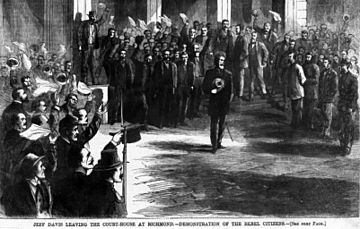
In his later years, Davis encouraged Southerners to be loyal to the United States again. He was helped by a wealthy widow named Sarah Anne Ellis Dorsey, who gave him a place to live and money to support himself. This allowed him to live comfortably with his wife. Jefferson Davis died on December 6, 1889, in New Orleans, Louisiana, at the age of 81.
Funeral and Reburial
Davis's funeral was very large, with an estimated 200,000 people attending. His wife, Varina, decided he should be buried in Hollywood Cemetery in Richmond, Virginia, which she felt was the right place for Confederate heroes. In May 1893, Davis's remains were moved from New Orleans to Richmond. Along the way, the train stopped in several cities, where people paid their respects. His children were also reburied there, and Varina was buried beside him when she died in 1906.
Political Views on Slavery
During his time as a senator, Davis supported the Southern states' right to own enslaved people. He believed that slavery was supported by religion and history. He claimed that it was good for both the enslaved people and the economy.
Legacy
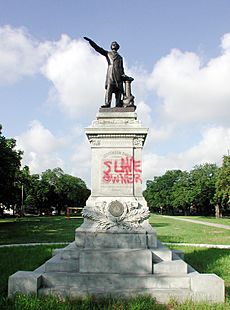
Jefferson Davis served the United States as a soldier and politician. However, he is mostly remembered for his role as president of the Confederacy during the Civil War. After the war, many people blamed Davis for the Confederacy's defeat. Later, some historians began to look at his leadership more closely, noting that he was a capable leader but faced huge challenges.
Images for kids
-
Wedding photograph (a daguerrotype) of Jefferson Davis and Varina Howell, 1845
-
The original Confederate Cabinet. From left: Judah P. Benjamin, Stephen Mallory, Christopher Memminger, Alexander H. Stephens, LeRoy Pope Walker, Jefferson Davis, John H. Reagan and Robert Toombs.
-
William T. Sutherlin Mansion, Danville, Virginia, temporary residence of Jefferson Davis and dubbed Last Capitol of the Confederacy
-
Funeral procession of Jefferson Davis in New Orleans
-
Jefferson Davis burial site at Hollywood Cemetery in Richmond, Virginia
See also
 In Spanish: Jefferson Davis para niños
In Spanish: Jefferson Davis para niños


